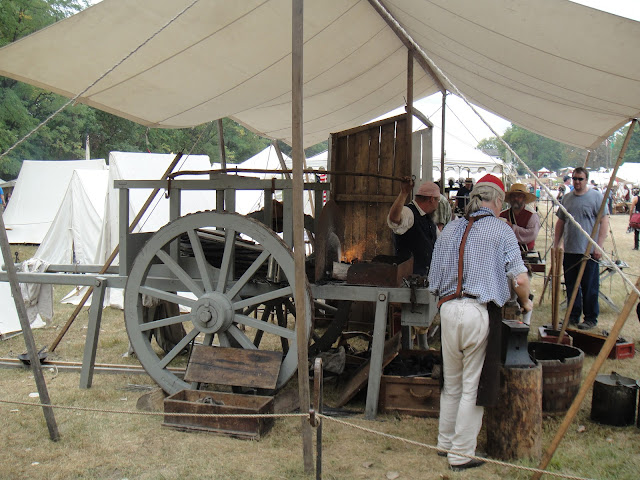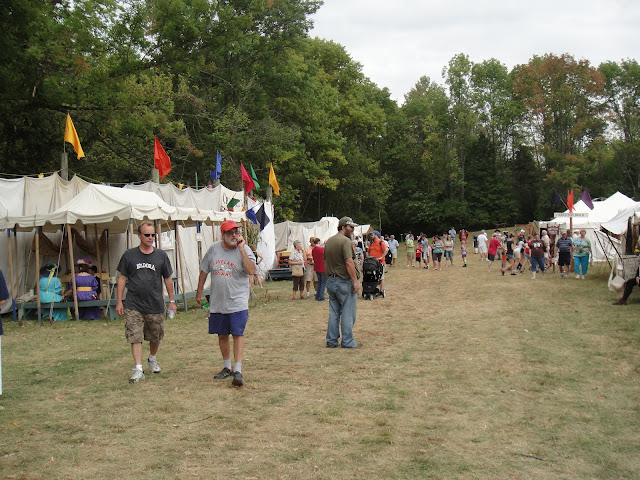This past weekend, I went out to Springfield, Ohio to see the early American reenacting event called The Fair at New Boston (link). The Fair is one of those sprawling events that one often hears spoken of in reenacting circles, but since it's not particular to the War of 1812 period and is civilian, artisan and merchant-oriented-- I've never been. This Saturday I decided to go in 21st century garb and see what the fair had to offer.
 |
| George Rogers Clark, who captured Vincennes during the War of Independence. |
After about 50 minutes driving, including an inadvertent detour through the center of Springfield, we arrived at the fair and were ushered by boy scout volunteers into a parking spot. The grass in the parking lot was tall enough to rattle against the floorboard of the car, but parking in the grass is something you get used to in the reenacting world.
The fair itself sprawled across a farm meadow and several clearings and hillsides. Merchants, artificers, and food venders were all laid out in a box-shaped encampment (mostly of spacious wall tents) with broad, regular avenues. The military camp, oddly enough, was very un-military. The wedge tents and flys were strung along a couple of walkways, interrupted by a picket line where several horses (a rarity at 1812 events) grazed and tolerated the children who came up to pet them. There was also a couple of artillery companies in separate areas of the camp, including a 3-inch howitzer and a light 6-pounder field piece manned by the Mad River Artillery Co (link) . Periodically they provided demonstrations for the crowd on the brow of a steep hill to one side of camp. There was even a stray detachment of the Royal Navy, flying a naval ensign that was unmolested by either the green coated US riflemen next door or the Kentucky mounted riflemen elsewhere in camp. However, I could see that there was little time for war with so much trade going on...
 |
| A naturalists writing table and specimens. |
 |
| A travelling forge, necessity for any army on campaign. |
 |
| The old method of cutting the bore of a rifle for grooves. |
In the bustling streets of the tent city below I met with a lot of familiar merchant companies, and some not so familiar (as this is to the south and earlier than most events I attend). Regency Revisited (link), Spencer's Mercantile (link ), and Smoke and Fire (link), were present, as was Flying Canoe (link). The First Regiment of Volunteers, an 1812 regiment (link), was busily recruiting in one of the market avenues, while blacksmiths, gunsmiths, and tinsmiths hawked wares even as they crafted more. Strapped for cash, I spent my last Spanish Dollar on a tow worm for cleaning my musket.
The taverns, coffee houses, and publick houses were doing a brisk business with fair goers and reenactors alike. Two great tavern tents were set up on either flank of the market, the Blackhorse Tavern and Little John's. Each reminded me of a scene from one of William Hogarth's engravings--albeit without the whoring, bear-bating and gambling that 18-th century city-dwellers would have enjoyed.
Further out in the midst of a woodlot lay the Indian encampment. It was pretty well populated with wigwams, lean-tos, and the occasional teepee. A great longhouse had been erected in the center of the village. A white artist was sketching the scene, while a couple of chickens clucked contentedly in a log hutch. Back in the main camp, entertainers regaled visitors on several stages situated throughout the market. The largest of these was the Cheapside Theatre, a set of canvas walls surrounding a open-air performance space. Other entertainers, such as the Clockwork Clown and my personal favorite, Common Stock, played on smaller stages or (in the latter's case) prowled the tent avenues. For those searching for erudition, there was a printer, a naturalist, and a Grand Camera Obscura built by Mr. John Stealey (--which I'd had the chance to see at Fort Meigs the week before).
Unfortunately, the atmosphere was more alike to the East Indies than old London or Philadelphia, and we were soon defeated by the humidity and swarms of yellow jackets. We left the fair feeling that we'd got the value of our $8 admissions.









No comments:
Post a Comment
Note: Only a member of this blog may post a comment.